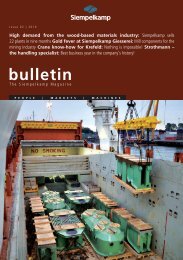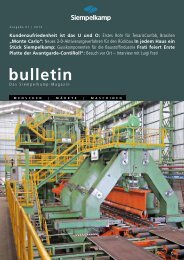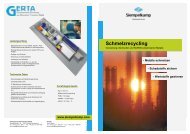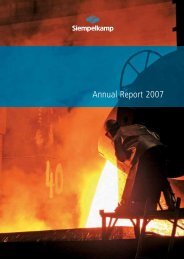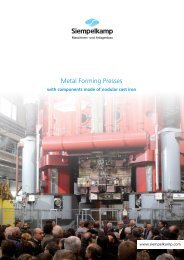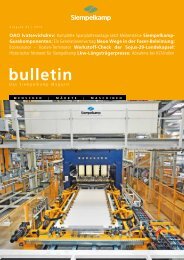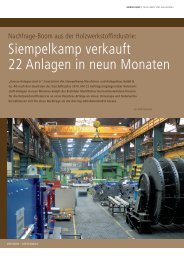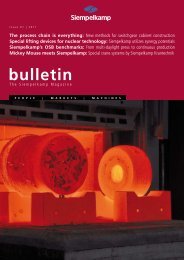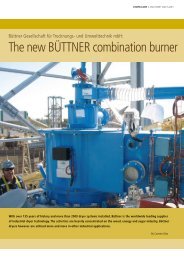Annual report 2009 - Siempelkamp
Annual report 2009 - Siempelkamp
Annual report 2009 - Siempelkamp
You also want an ePaper? Increase the reach of your titles
YUMPU automatically turns print PDFs into web optimized ePapers that Google loves.
<strong>Siempelkamp</strong> Casting technology<br />
Foundry<br />
In the area of general machine engineering <strong>Siempelkamp</strong> castings are used as gearbox housings, machine beds or roll housings. For<br />
rolling mills, <strong>Siempelkamp</strong> Foundry casts both the roll housing and frame as well as the smaller chocks and inserts from cast iron with<br />
nodular graphite. The mill housings have a raw cast weight of up to 160,000 kg (176 US tons). The smaller chocks and inserts can<br />
weigh up to around 15,000 kg (16.5 US tons).<br />
Another market for our products is in press construction. Especially in regard to our cooperation with the machinery and plants<br />
business unit, we have had a high demand for our products for the construction of metal forming presses, tile presses and plastic<br />
injection molding machines. On May 19, <strong>2009</strong> we cast the world’s heaviest casting made of cast iron with nodular graphite, an upper<br />
beam for a straightening press with a raw cast weight of 252 t (278 US tons).<br />
For the nuclear technology business unit we produce cooling elements for the Core Catcher, a safety structure in nuclear power plants<br />
(see page 87).<br />
Record casting in May <strong>2009</strong>: world’s heaviest casting made<br />
of nodular graphite cast iron<br />
In 2008 Dillinger Hüttenwerke AG commissioned <strong>Siempelkamp</strong><br />
with a new straightening press for heavy plates. For the upper<br />
bolster of the press the company poured within two minutes 270 t<br />
(297 US tons) of molten iron into a mold with a length of approx.<br />
10 m (33 ft) and a width of 3.2 m (10.5 ft). With this casting the<br />
Krefeld company beat its own world record from 1998. The<br />
project was a technological and logistical challenge. The entire<br />
amount of molten iron had to be available in fi ve pouring ladles<br />
at the same time with exactly identical properties and the same<br />
temperature of 1,350 °C (2,462 °F). After the casting process, the<br />
iron required approx. four weeks to cool down to a temperature<br />
of approx. 300 °C (572 °F). Not until then were the <strong>Siempelkamp</strong><br />
specialists able to remove the bolster from the mold and fi nd out,<br />
after fettling and inspection, whether the casting was successful!<br />
Removing a casting from the casting pit<br />
Core Catcher cooling elements for a nuclear power plant<br />
in China<br />
In cooperation with <strong>Siempelkamp</strong>’s nuclear technology business<br />
unit, we offer the casting of Core Catcher cooling elements. In<br />
<strong>2009</strong> SNT ordered from the foundry further elements for a Core<br />
Catcher cooling structure at the nuclear power plant Taishan, unit<br />
I and II. This is the third order for the manufacture of cast parts<br />
for the safety system Core Catcher of the EPRTM reactor that the<br />
foundry has carried out.<br />
Molding of the Core Catcher fl oor elements<br />
78 79




